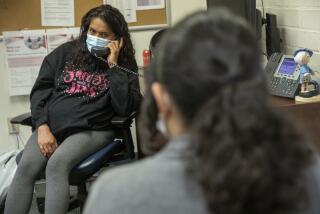County Welfare System Flawed Despite Reforms, Survey Finds
- Share via
Despite dramatic changes that have overhauled California’s welfare system, the county welfare department is still not adequately serving recipients, according to a report released today--the one-year anniversary of CalWORKS in Los Angeles--by the Welfare Reform Coalition.
The survey of nearly 1,400 welfare recipients conducted by the Imoyase Group, an independent program evaluation organization, found that a significant number of them were poorly informed about basic rules, spent too much time waiting in welfare offices and did not feel they were treated with respect by county employees.
“Any business doing these things would go out of business,” said Sam Mistrano, executive director of the Human Services Network of Los Angeles, which organized the Welfare Reform Coalition.
“It’s just horrible,” said Michele Broadnax, co-chair of the coalition, which consists of about 190 service agencies, churches and nonprofit agencies in the Los Angeles area. “The welfare-to-work system, as it’s implemented in L.A. County, isn’t serving the people.”
The report calls for better staff training for county welfare workers, shortening client waiting times and improving communications. It also recommends that the county hire an independent auditor to examine the CalWORKS application system.
CalWORKS, which stands for California Work Opportunities and Responsibilities to Kids and replaced the Aid to Families With Dependent Children program,revolutionized the state’s welfare system by instituting five-year lifetime caps on cash benefits for most adults and required them to work or engage in welfare-to-work activities, such as searching for work or taking job training classes.
The respondents in the study, who were selected at random from welfare offices, housing projects and service agencies from November 1998 to February, were asked to grade their experiences on a scale of A to F.
Out of a possible 4.0 grade-point average, they gave the department a 2.04, or a resounding C, on how well the new rules were explained to them. About 42% knew nothing about lifetime limits and 65% said they did not know they could request support services for domestic violence, mental health or substance abuse.
Respondents also gave the county a barely passing grade of 1.87 when asked about the efficiency of the application process. Nearly a third reported spending more than six hours waiting in a welfare office on the day they applied, and almost half said they made three or more trips to an office to determine their eligibility.
When asked whether county employees treated them with respect, recipients gave a grade of 2.08. African American respondents reported feeling the least well respected, compared to other races and ethnicities surveyed.
The study found that the county did well in one area: serving non-English speakers. Among them, 91% said they had a caseworker who spoke their language and 84% said they received written materials in their language.
“Spanish speakers are well served,” said Bill Gallegos, co-chairman of the coalition, but he added that speakers of other languages, such as Tagalog and Armenian, are still underserved.
Responding to the study, Sandra Semtner, special projects division chief for the county Department of Public Social Services, which runs the program through 29 offices, said: “CalWORKS to some extent is a work in progress. We welcome any input into the process.”
She said a tedious welfare application system “is kind of the nature of the beast.”
“We would like to see it streamlined also. But the bottom line is, the federal and state rules to determine eligibility are complicated,” she said. The county has also been working on its own report “to identify what’s working and not working” at welfare offices and will release its findings later.
More to Read
Sign up for Essential California
The most important California stories and recommendations in your inbox every morning.
You may occasionally receive promotional content from the Los Angeles Times.












